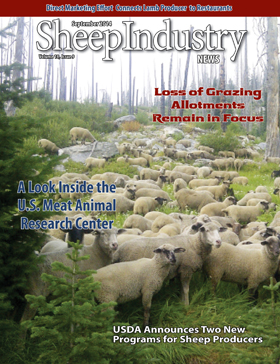
- September 2014
- President’s Notes
- Market Report
- Commentary: Stand Against Activist Organizations
- Direct Marketing: Watson’s Direct Marketing Approach Includes ‘Custom Growing’ Lambs for Fine Restaurants
- Easycare Sheep and Elimination of OPP Focus of U.S. Meat Animal Research Center
- Listening Sessions Invoke Support for U.S. Sheep Experiment Station
- Loss of Grazing Allotments Remain in Focus
- Undersecretary Visits ASI Office to Announce Programs That Will Benefit Sheep Producers
- Washington Rancher Allowed to Defend Flock in Wake of Wolf Attacks
- News Briefs
To View the September 2014 Digital Issue — Click Here
Tracks of (past) Time
Producers across the U.S. were once heavily dependent on railroads to move their sheep to major stockyards
By Clint Krebs
A s I continue providing some history of the sheep industry over the last 150 years, I want to remind people to please send in their stories. We will compile them for the convention.
In my opinion, the biggest change for the sheep industry over the last 150 years has been the railroads.
At the turn of the century, the sheep industry was completely dependent on rail transportation to not only move the livestock, but to move the meat. Some 80 years later, we will not use the railroads at all.
Our ranching operation used the rails for over 50 years to move our sheep from Oregon to Montana – and then back home again. The lambs were shipped by rail to South Saint Paul for harvest and the meat was probably shipped further east.
We certainly weren’t the only ones doing this, and the reasons why it was common practice were because we didn’t have the infrastructure to harvest the numbers of lambs we were raising in the west, and we didn’t have enough consumers to eat what was produced.
There were refrigerated freight cars, but they certainly had reliability issues so the solution was to send the livestock to the consumer. This led to the building of huge stockyards and processing facilities in places like Denver, Fort Worth, Kansas City, and Chicago.
There were also hundreds of smaller stockyards like Portland and Dixon, but they all had one thing in common – at least one rail line coming in, if not two or three railroads, and at least one meat packer.
Every one of these stockyards can tell a story, but my favorite is Kansas City. It operated from 1871 until 1991 on over 55 acres of land within the city limits. In 1923, a total of 2,631,808 head of cattle were received, along with an additional 377,038 calves. Exactly 2,736,174 hogs were received, along with 1,165,606 head of sheep.
In addition, 42,987 head of horses were auctioned off. At one time, 16 different railroads converged at the Kansas City Stockyards. The logistics of efficiently handling these kinds of number fascinate me. How many people did it take just to scoop out the empty railroad cars every day?
The Union Stockyards in Chicago opened in 1865, the same year the Nation Wool Growers was founded. In 1924, there was more meat processed in Chicago than any other place in the world, and they operated until 1971.
By then, the meat packing industry was decentralized and moving away from their urban settings; and their dependence of the railroads.
The Union Stockyards were huge, covering over 375 acres and they were financed by a consortium of nine different railroads. They had enough pen space to hold 75,000 hogs, 21,000 cattle, and 22,000 sheep at any one time. By 1890, they were processing 9 million animals annually, and employed more than 25,000 people.
The size and scale of the stockyards allowed for the creation of some of America’s first global companies like, Swift, Wilson, and Armour.
In 1955, Chicago-based Armour was among the world’s largest companies, ranked by the Fortune 500 as No. 7, which meant they were bigger than companies like Gulf Oil, and Bethlehem Steel.
So the railroads moved people west, and then moved the livestock produced from these immigrants east to these stockyards, (which they owned for the most part), and then moved the meat east again.
Over the last 150 years, the role played by railroads has been a huge asset to not only the sheep producers nationwide, but they made our whole country stronger. I have personally loaded and unloaded hundreds of railroad cars and have ridden the rails many times.
Today, many of the residents of the urban cities seem to have forgotten their towns were probably founded and became profitable by the railroads bringing in jobs and developing markets, and shipping further processed items out to the ultimate consumer.
The only thing I see coming out of these urban areas now “by rail” is the gang graffiti painted on the cars.

